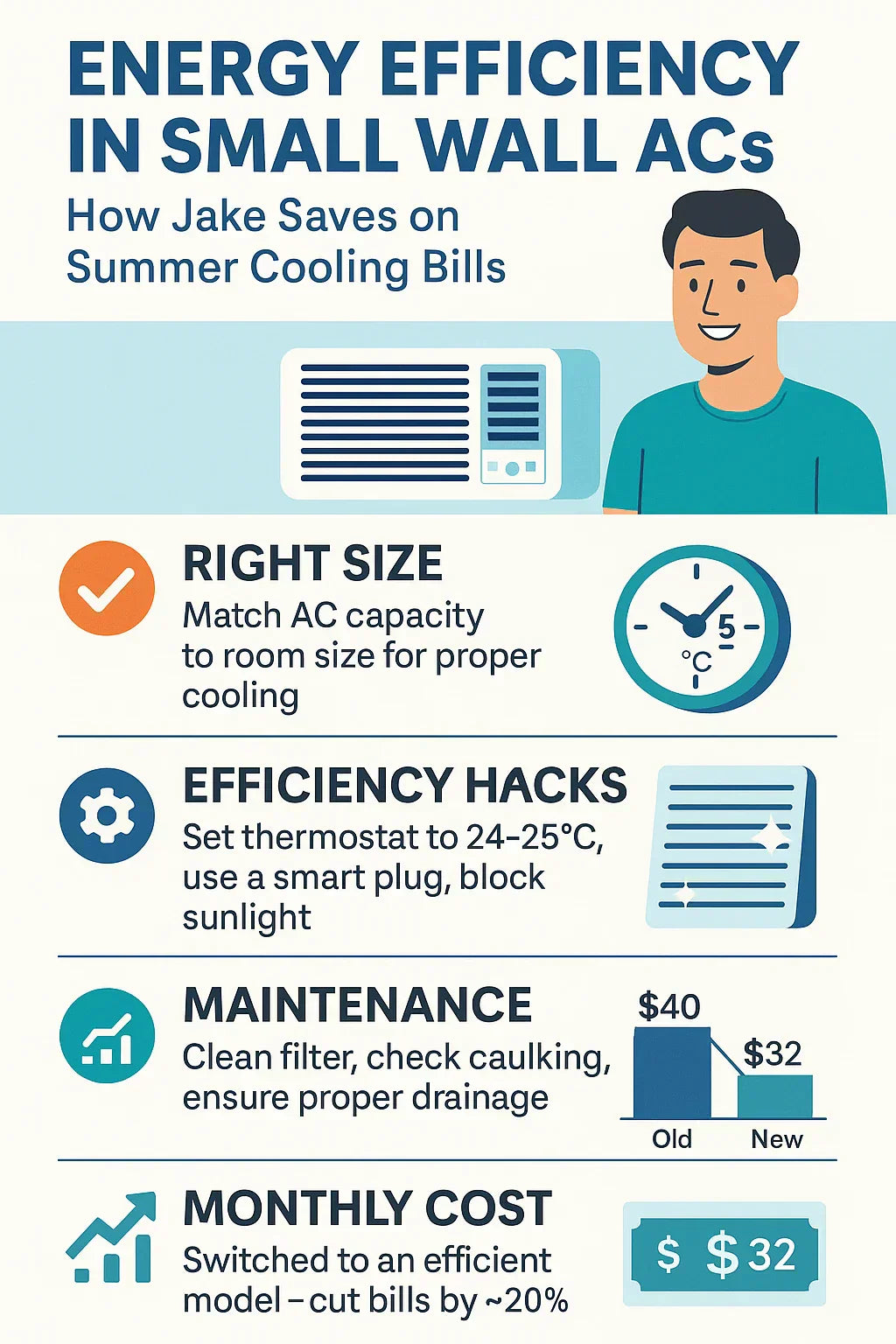🌬 Introduction
Every summer, Jake used to dread opening his electric bill. Running his old through‑the‑wall AC (8,000 BTUs) meant $100+ per month in cooling costs.
Last year, he decided enough was enough. He researched energy efficiency, upgraded his unit, changed some habits, and cut his summer bills by 20% without sacrificing comfort.
In this guide, you’ll learn the same steps Jake followed to maximize efficiency in 6,000–9,000 BTU wall ACs—the most popular size range for bedrooms, small living rooms, and home offices.
We’ll cover:
-
How to size your AC properly
-
Which efficiency ratings matter
-
Jake’s proven hacks to lower cooling bills
-
Maintenance routines that keep your AC performing
-
Real‑world cost savings
🧮 The Basics of Efficiency in 6k–9k BTU Wall ACs
📏 Why Proper Sizing Matters
The most overlooked factor in AC efficiency is sizing.
-
Undersized (too small): Runs nonstop trying to cool the room, consuming excess energy.
-
Oversized (too big): Short‑cycles (turns on/off frequently), leading to poor humidity control and wasted power.
Jake follows the 20 BTU per square foot rule:
| Room Size (sq ft) | Recommended BTUs |
|---|---|
| 150–200 | ~6,000 |
| 200–300 | ~7,000–8,000 |
| 300–400 | ~9,000 |
Example: Jake’s 240 sq ft home office → 240 × 20 = 4,800 BTU → round up to 6,000 BTU.
📌 Reference: PickHVAC BTU Sizing Chart.
🔑 Understanding Efficiency Ratings
Jake learned to read the labels, not just the price tag.
-
EER (Energy Efficiency Ratio): BTUs ÷ watts consumed. Higher = better.
-
CEER (Combined Energy Efficiency Ratio): Same as EER, but includes standby energy use (a more accurate real‑world measure).
-
ENERGY STAR certification: Units with this label are 10% more efficient than standard models
Jake chose an ENERGY STAR 8,000 BTU wall AC with a CEER of 11, cutting his power use by ~15%.
⚡ Jake’s Hacks for Lower Cooling Bills
Jake didn’t stop with buying a better unit—he changed his daily habits too.
🕒 Smart Usage Habits
-
Thermostat setting: Jake sets his unit to 24–25 °C (75–77 °F). Each degree higher saves ~3–5% on cooling costs (Better Homes & Gardens).
-
Smart plug scheduling: He programs his unit to turn off when he’s out of the house.
-
Pre‑cooling: On hot days, Jake runs the unit early in the morning when outdoor temps are lower, so it doesn’t work as hard later.
🌞 Sunlight & Insulation Tricks
Jake discovered that blocking heat gain made as much difference as running the AC.
-
Blackout curtains: Block up to 30% of heat from windows.
-
Weatherstripping: Stops hot air from seeping in around the wall sleeve.
-
Proper sealing: A bead of caulk around the sleeve perimeter saves Jake ~10% on bills.
📌 The U.S. Department of Energy confirms proper insulation can reduce cooling loads significantly.
💨 Air Circulation Boosters
-
Ceiling fans: Allow Jake to set his thermostat 2–3 °F higher without losing comfort.
-
Floor fans: Help push air into corners of his open‑concept space.
-
Open doors: Improves circulation across rooms, reducing AC strain.
🛠 Maintenance Tips That Boost Efficiency
Jake follows a seasonal checklist to keep his AC in top shape.
🧼 Filter Care
-
Wash reusable filters monthly.
-
Replace disposable ones every 30–60 days.
-
Dirty filters can increase energy use by 5–15%.
🔧 Seasonal Checks
-
Vacuum dust from condenser coils each spring.
-
Ensure the sleeve has a slight outward tilt for proper drainage.
-
Inspect caulking for cracks or gaps.
🐜 Preventing Obstructions
-
Trim shrubs or remove clutter outside that might block airflow.
-
Keep the vent area inside clear of curtains or furniture.
📌 Family Handyman recommends seasonal cleaning as the #1 way to extend AC life and reduce energy costs.
💵 Real Cost Savings: Jake’s Example
Jake compared his old unit (non‑ENERGY STAR, CEER 9) with his new one (ENERGY STAR, CEER 11).
Old Unit
-
Wattage: ~950 W
-
Hours/day: 8
-
Monthly usage: 228 kWh
-
Cost at $0.15/kWh: $34/month
New Unit
-
Wattage: ~750 W
-
Hours/day: 8
-
Monthly usage: 180 kWh
-
Cost at $0.15/kWh: $27/month
Savings: $7/month × 4 months = $28 per summer
With smart plug + insulation, Jake’s actual savings = ~$60 per summer.
📌 Energy Star estimates homeowners save $60–$100 annually with certified models.
📊 DIY Upgrades for Extra Efficiency
Jake didn’t stop at basics. He invested in small upgrades that paid off quickly.
-
Insulated side panels: Reduce leaks around the unit.
-
Smart thermostat integration: Syncs his wall AC with his home’s schedule.
-
Standalone dehumidifier: Cuts the AC’s workload on muggy days.
-
Newer unit upgrade: If your wall AC is 7+ years old, efficiency may be 20–30% worse than today’s models
✅ Jake’s Energy Efficiency Checklist
-
Room size matches AC BTU capacity
-
ENERGY STAR or CEER ≥ 11
-
Filters cleaned monthly
-
Curtains & insulation reduce heat gain
-
Smart scheduling in place
-
Sleeve caulking inspected each spring
-
Tilt confirmed for proper drainage
🏁 Conclusion
Jake’s big discovery: energy efficiency is a mindset. It’s not just about buying a certified wall AC—it’s about how you install it, maintain it, and use it every day.
With the right size, smart habits, and seasonal care, Jake now stays cool all summer while saving 20% or more on his cooling bills.
And you can too.
In the next topic we will know more about: Top Brands for 6,000–9,000 BTU Wall ACs: LG vs. GE vs. Amana







